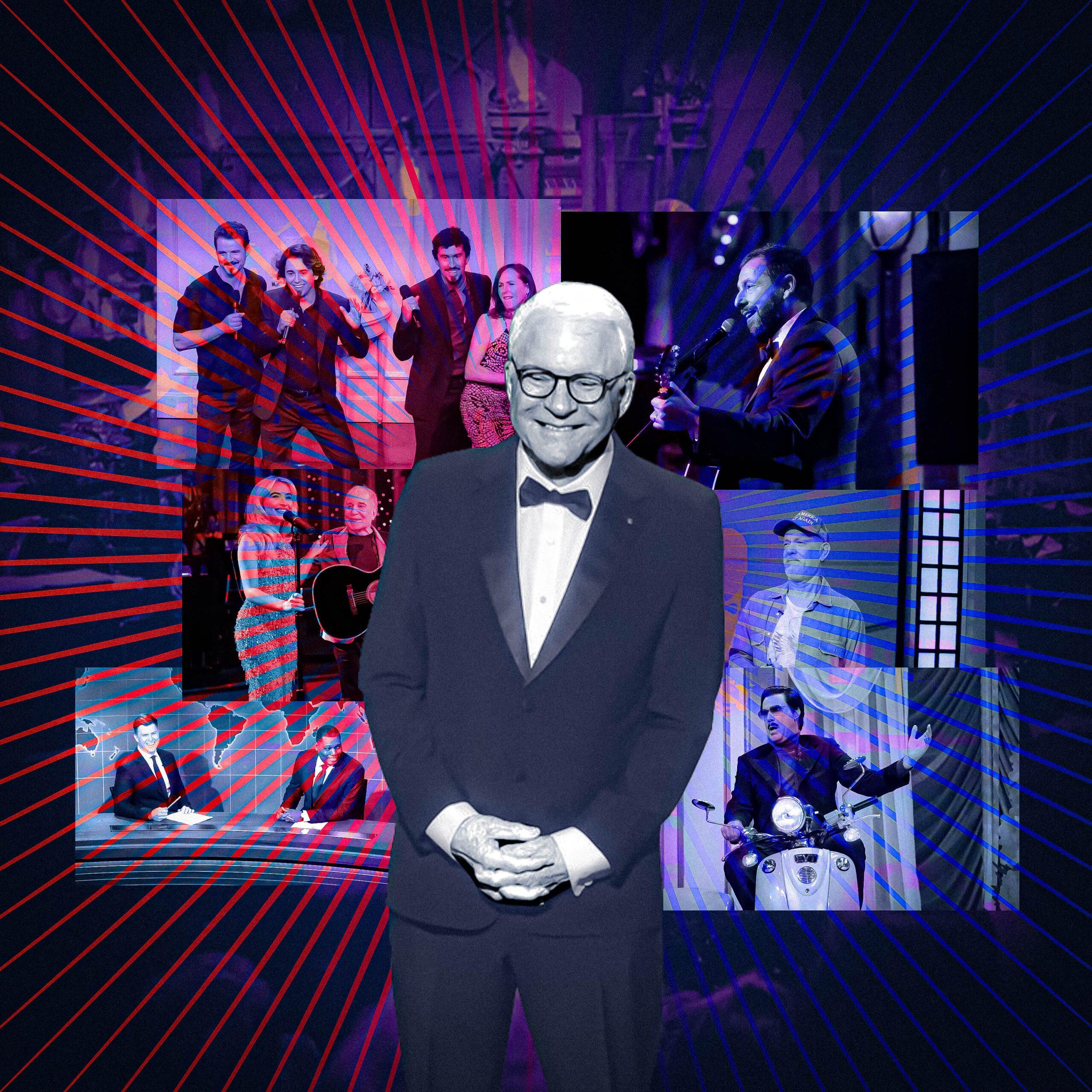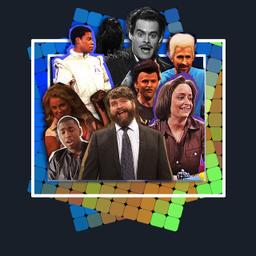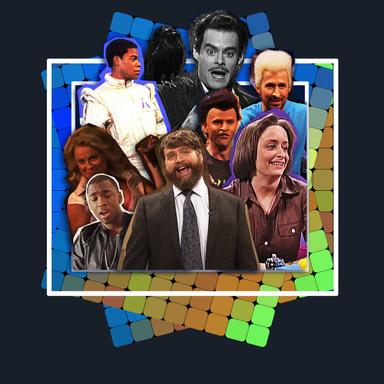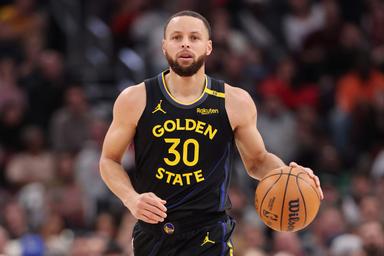
“SNL50” began by attempting to bridge the generation gap. Paul Simon—boomer icon, Lorne Michaels bestie, Saturday Night Live mainstay since Season 1—performed “Homeward Bound” with Sabrina Carpenter, a Gen Z star who only recently became a household name for many adults.
“I sang this song with George Harrison on Saturday Night Live in 1976,” Simon said from the Studio 8H stage, the first of the night’s many callbacks to the show’s history. “I was not born then,” Carpenter quipped. “And neither were my parents.”
The lovely ballad that followed opened SNL’s 50th anniversary special on a surprisingly somber note. The melancholia carried through to the finish nearly three and a half hours later, when Harrison’s old bandmate Paul McCartney rolled through the closing medley from Abbey Road—the one that ends with “The End.” (Shout-out Chris Farley.)
SNL has celebrated itself many times over the years, including with specials to mark the show’s 15th, 25th, and 40th anniversaries. But 50 years is an especially momentous milestone, and NBC has celebrated it with an astonishing flood of content. NBCUniversal did not produce Saturday Night, last year’s feature film about the frantic final hours leading up to the first SNL episode. But NBC did do the four-part Peacock docuseries SNL50: Beyond Saturday Night, another doc called Ladies & Gentlemen… 50 Years of SNL Music (codirected by Questlove), and Friday night’s SNL50: The Homecoming Concert, a star-studded music extravaganza at Radio City Music Hall.
The nostalgia came to a head Sunday night in prime time, live from New York in front of an audience stuffed with celebrities from Jack White to Jenna Ortega. Half a century is an awfully long time for a television show to persist, even one that sheds its skin as often as SNL, and all that time hung heavy over the “SNL50” broadcast, including in the visibly aged visages of figures like Michaels, McCartney, and Simon. Even in the moments of hilarity, which the show did eventually supply, there was a funereal quality to it, as if all these famous people were throwing a wake for an institution and its era.
The show is not in danger of being canceled—it maintains surprisingly strong ratings even two decades after its sketches first became YouTube fodder—yet SNL as we know it will inevitably come to an end soon. Michaels, the quiet but opinionated Canadian who willed the show onto the air in 1975 and has built it into his personal fiefdom, is 80. He looked verklempt in the final moments of Sunday’s show, surrounded by dozens of SNL fixtures and affiliates. Though the notoriously cagey Michaels has avoided giving firm answers about a succession plan or whether he’ll hang it up after the 50th season, it’s hard to imagine him keeping up SNL’s punishing weekly grind much longer. All these festivities afford him the ideal opportunity to step aside in favor of, as the buzz suggests, a longtime lieutenant like Tina Fey or Seth Meyers.
The onslaught of SNL anniversary programming has also served to clarify what kind of entity the show has become. At the peak of its powers, the series has been both a driver of culture and a time capsule, an organization able to break new talents, ride the zeitgeist, and shape public perception of political power players. It can also sometimes feel like a monument to itself—a Saturday Night Live admiration society bought into narratives Michaels has been pushing since before the show was on the air.
When it arrived in 1975, SNL was both promoted and received as a revolutionary force, a jolt of youthful energy and countercultural chaos in a medium ruled by prim, proper variety shows. In the opening moments of Beyond Saturday Night, former cast member Joe Piscopo excitedly explains that SNL turned comedy into rock ’n’ roll. And like rock ’n’ roll, after a while the revolution became its own kind of establishment—so much so that later in the docuseries, current SNL writer Celeste Yim can rightfully call it “the most corporate comedy job in the world.”
Yet if SNL has become the comedy equivalent of classic rock, “SNL50” was not strictly about playing the hits. There were montages chronicling the show’s best physical comedy (from Chevy Chase to Molly Shannon) and fake ads (Taco Town!), but the show also punctured its own air of awards-ceremony reverence with an “In Memoriam” segment focused on bits “that have aged poorly,” a brilliant exercise in having your cake and eating it, too. Several “YIKES” captions were involved, as was footage of a dreadlocked Adrien Brody that may or may not have gotten him banned from the show.
The special was at its best when it focused less on shtick and more on the kind of pure magnetism that can’t be taught. The returns of long-retired characters like Mike Myers’s Coffee Talk broad Linda Richman, Will Ferrell’s Robert Goulet, and Rachel Dratch’s Debbie Downer largely fell flat, but were outnumbered by segments that let some of the show’s greatest alumni cook. Bill Murray ranking “Weekend Update” anchors? Gold. Kate McKinnon portraying a trashy alien abduction survivor? Genius. Eddie Murphy doing a pitch-perfect Tracy Morgan impression in “Black Jeopardy!” while standing shoulder to shoulder with the real Tracy Morgan? Hook it to my veins.
Similarly, rather than having Adam Sandler trot out one of his old hits like “Lunch Lady Land,” the SNL brass let him perform a new original song commemorating the show’s history, which managed to be both humorous and heartbreaking. At first, Sandler’s “50 Years” risked succumbing to the same inside-baseball navel-gazing that befell Andy Samberg and Bowen Yang’s disappointing digital short about how everyone at SNL had anxiety. But by the end, when the Sandman was paying tribute to Farley and other late cast members like Phil Hartman and Jan Hooks, he had some of us on the verge of tears—not a development I ever expected from the guy who once released “Piece of Shit Car,” even in his post–Uncut Gems elder statesman era.
On a night when some of the musical performances were anticlimactic—Lil Wayne’s perfunctory medley with the Roots, Miley Cyrus and Brittany Howard’s weirdly muted “Nothing Compares 2 U” in Sinead O’Connor’s honor—Sandler’s acoustic tune was a reminder of how potent SNL can be at the intersection of music and comedy. So was John Mulaney’s madcap tribute to New York through the decades, which involved Maya Rudolph dressed as a heroin syringe, Adam Driver in a hot dog costume, and Nathan Lane parodying his Lion King classic “Hakuna Matata” as an ’80s businessman fueled by “cocaine and some vodka.”
Mulaney’s over-the-top Big Apple medley made great use of the wealth of celebs on hand, an antidote for thinner sketches that seemed to exist strictly as an excuse to cram famous faces into the frame. “SNL50” was in part about making SNL seem like the center of the universe by saturating Studio 8H with hundreds of stars, overwhelming the viewer with former cast members, hosts, and musical guests. The question remains whether the show can continue to feel so central, so weighty when it loses its founder, the force of gravity around which all else orbits.
Michaels did leave SNL once before, for five seasons between 1980 and 1985, then returned to the helm for Season 11 with the show on the brink of cancellation. He weathered that storm and many others like it down the line—one of the most storied SNL traditions is complaining it ain’t what it used to be—while gradually expanding his empire beyond Saturday nights. SNL alumni have been on screens and in writers rooms across the comedy landscape, from the sharp satire of Veep to the absurdist sketch comedy of I Think You Should Leave to the plucky, feel-good sitcom Parks and Recreation. Michaels also produces The Tonight Show Starring Jimmy Fallon and Late Night With Seth Meyers, both hosted by former SNL guys. Given the upheaval the show represented at first and the influence it has wielded since, there’s a case to be made that you can trace the whole modern comedy landscape back to Lorne.
That means, like so much pop culture that has endured from the 20th century into the 21st, that it’s a landscape molded by baby boomers, who’ve worked hard to canonize their contributions to pop culture (and imprint them on the minds of their millennial children). We’re a long way past the Not Ready for Prime Time Players, and the current SNL cast has brought their own sensibilities to bear on the show. Yet the likes of Bowen Yang and Sarah Sherman are not exactly overhauling the pre-established concept of SNL that Michaels has been subtly honing for decades. The show is his baby, and its extended roster of affiliates and friends shows how robust his Rolodex is.
For now, Michaels and his team continue to find young talent that operates on SNL’s wavelength. Carpenter is the latest young star to intuitively grasp the show’s ethos. On “SNL50,” after duetting with Simon, she played a key role in a recurring sketch that previously featured Ariana Grande, another pop star with impeccable comic instincts. Last month, Timothée Chalamet hosted for the third time; Billie Eilish has already become an SNL fixture. It reflects positively on SNL’s future vitality that some of the most popular young stars in show business gravitate to Studio 8H. But it also feels meaningful that many of the young standouts within the SNL universe are old-fashioned entertainers like Carpenter and Grande, not boundary-pushers continuing to redefine the face of comedy.
Perhaps because it was an anniversary show, so much of Sunday’s broadcast seemed focused on the old-timers. Steve Martin gave the opening monologue, while Martin Short said the goodbyes. A seemingly depleted Jack Nicholson showed up to introduce Sandler. The vast majority of stars who made cameos have been alive since before SNL came on the air. The highlights were plentiful, but it felt like a celebration of a bygone phenomenon, not a currently vital creative force. It will be interesting to see whether Michaels’s departure will bring back some of that old rupture or sap the life out of SNL for good.





